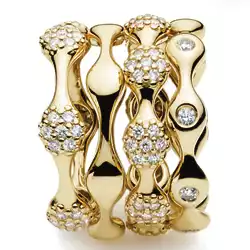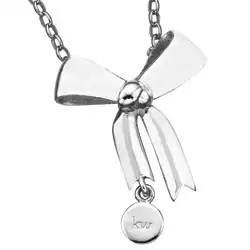Secrets of jewellery branding success
 15.2 k views | By Naomi Levin
15.2 k views | By Naomi Levin
Sure, Tiffany’s little blue box is the most powerful jewellery branding icon in the world – but how can smaller manufacturers, suppliers and retailers cash in on the cachet of brands? Naomi Levin reports.
That little blue box with its glossy white bow represents what is arguably the most famous jewellery brand in the world. While the quality and craftsmanship of Tiffany jewellery is not denied, few would insist Tiffany offers the absolute best, most innovative or finest items available. Similarly, Tiffany is not that hard to find – it has seven Australian stores, outlets in major international airports and its website includes a comprehensive online shopping site with inexpensive shipping. Tiffany also has numerous price points, making it affordable to all.
However, the fact that it is quite common, many of its designs are no longer particularly unique and it can be purchased by almost anyone does not stop females of all ages gawking through Tiffany windows and cutting out advertisements from glossy magazines to put on their Christmas, anniversary or birthday wish lists. So what is it that makes it the most coveted of all jewellery? Branding.
So entrenched is Tiffany’s appeal that Australian fashion bible Grazia had no qualms bestowing it with the accolade of Australia’s Favourite Jewellery Store in its inaugural Shopping Awards this May – voted for by 20,000 consumers. Grazia editor Kelly Hush attributed the brand’s historic popularity at least in part to its accessibility: “The collection is aspirational as well as offering more affordable pieces, so readers feel they too can take part in the Tiffany & Co experience,” she said.
“You may not be in the legendary Fifth Avenue boutique but you are still able to experience the world-class service and product in Sydney, Melbourne and Perth.” The secret to Tiffany’s continued success, it would seem, is its ability to present an image of exclusivity while in reality offering something for everyone, everywhere.
Tiffany has been branding its jewellery since its beginnings in New York in 1837. It first used its blue colour in marketing – trademarked Tiffany Blue – in 1878. Around the same time, Cartier began manufacturing in Paris, selling its wares under its house-name to royals and aristocrats, Bulgari did so from 1884 in Italy. These brands’ prestigious heritage and long-standing popularity no doubt eases the task of communicating their ‘stories’ and the basis of their worth to consumers.
Michel Hogan, founder of branding consultancy Brandology, calls Tiffany, Cartier and Bulgari “destination brands” – “People seek them out for not only the product, but the cachet it carries.” More generally, she says branding has become a way for manufacturers, suppliers and retailers to encourage customers to step out of their day-to-day transactional buying habits.
The recent boom in branded jewellery signals that there is certainly scope and demand for more jewellery brands and, done well, stocking brands can result in a real business boost. However, branding might be easy for global heritage powerhouses like Tiffany – but how can smaller retailers, manufacturers and suppliers ensure they stand apart from the crowd instead of languishing in a sea of uninspiring, ‘me-too’ brands? Homogenisation is an ever-present danger.
Good branding, Hogan says, is about influencing buying behaviour and building customer loyalty. This can be done in two ways: first, by meeting customer expectations and second, through alignment. “Consistently meeting expectations with your customers is the number one way to build brand strength. All the great marketing in the world won’t do a thing for you if the promises you are making are not kept,” she explains. “Also important is aligning what you say and what you do. It is no good promising a high-quality product and then handing it over the counter – or sending it out – in a cheap package.”

Pandora
Increasingly important among brands is the internet. Hogan says there are few businesses that can get away without some sort of web presence. Interestingly, Tiffany was ranked eighth in a “digital IQ” survey conducted last year by digital innovation think tank L2 – yet many of the other luxury watch and jewellery brands lagged behind their counterparts in other retail categories. While big brands scored poorly for ignoring social media and for having non-existent web presences, research suggests that small businesses are better placed to take advantage of this branding avenue because they can offer a more intimate, friendly persona beyond the corporate face.
However, Hogan warns that the internet is just one branding strategy. “Websites, social media and other online models are just tools,” she says. “What does your brand stand for? Who are you trying to reach? What is the best way to reach them? These are the questions businesses need to be considering as they look at their online presence.”
For some suppliers and retailers, a website incorporating an online store may be a golden marketing strategy, especially considering earrings, pendants, rings and other pieces are small and easy to ship. But Hogan advises exercising caution in this area. “Let’s say that a key part of your brand is the personal advice and service you provide in-store at the time of purchase. That can be hard to replicate online, so that business would need to look at whether selling online was the best way to support that brand.”
An increasingly important part of the online commercial sphere is social marketing via Facebook, YouTube and Twitter. However, the industry is divided as to whether social media can actually increase sales. Hogan believes it should not be seen as a selling strategy, but a communications mechanism designed to engage with customers both current and future. She cites US airline Jet Blue as a company that has benefitted from social media use: “Jet Blue has garnered a lot of attention for its proactive use of social media to let its followers know about travel problems, special offers and events, and engage in a conversation about their travel experience,” she explains.
For both jewellery suppliers and retailers, social media offers an opportunity to directly connect with customers to tell them what’s new, what’s available, where to get it and to give them a reason to feel positive about the brand.
Kate Sutton’s Uberkate brand does exactly this via Facebook, Twitter and a blog. “Social media has given us the opportunity to directly communicate with our customers, which enables us to better understand who our customers are and we really listen to what they are telling us,” she explains.
More than 3,000 people are “fans” of Uberkate on Facebook and these people use the web page to provide feedback on their favourite pieces. “This form of communication is very empowering for clients and they feel connected to our brand because they are included in the journey,” she says. “We also regularly reward our fans by giving away products and offering specials to customers who liaise with us through social media and this really helps build brand loyalty.”

Karen Walker
Iconic Jewellery has also introduced a major online campaign to help launch the supplier’s newest line, The Confidante Dolls. “More and more importance is being placed on a web presence,” Iconic’s Maria Vella says. “We recognise the power of the media and its influences and we have decided to rebuild our own website alongside our product sites.”
The Confidante Dolls website provides information about the product: gem-set sterling silver babushka-style pendants, charms and earrings. However, a sign of the times is the “stories” sub-section, which invites customers to share their reason for buying a Confidante Doll and their feelings about their new piece of jewellery. There are plans to make the site even more interactive. “The website has the facility to link to The Confidante Dolls Facebook page, and there is work in progress constructing a Confidante Dolls [smartphone] app,” Vella says.
Confidante Dolls designer Sarah-Jane Adams, who also owns boutique jewellery supplier SJ Jewels, is new to the concept of branding and has taken a long time to come around to the idea of building a branding strategy into her business. Increasingly, it would seem, designers are recognising the benefits of marketing an identity for their jewellery.
What of the future? Although it’s hard to say where branding will go, Hogan believes brands will have to work hard to keep up demand and maintain integrity in a transparent age. “Brand is the result of the promises you keep, so as the internet and particularly social media drive greater visibility of what brands do, over what they just say, more and more businesses will be forced to consider their brands as integral drivers of the whole business,” she says.
Showcase Jewellers spokesperson Antonia Kratsas believes that for those on the retail side, the future of branding is a real unknown. “The notion of branding jewellery is still quite new to our industry so I guess anything is possible,” Kratsas says. “[But] there needs to be some perceived added value on the consumers’ part if, for example, we’re going to ask them to start paying a premium for say, a basic gold chain.”
Chris Worth of supplier Worth & Douglas says that if you put yourself in shoppers’ shoes, it’s not hard to see why branded jewellery could continue to be a money-spinner for retailers: “We know as consumers ourselves that we can trust the quality of a brand and can easily develop a personal connection to a brand,” he says. “People love wearing jewellery that receives brand recognition among their friends or peers and this is one of the main benefits of branded jewellery – it gives a range an identity, and a successful brand will bring people back time and time again.”
And if jewellery brands can continue to build on that magic mantra of brand identity, customer recognition, and repeat business, there’s no reason why this area of the market shouldn’t enjoy further growth – and not just when it comes to Tiffany’s little blue box.
Posted July 01, 2011